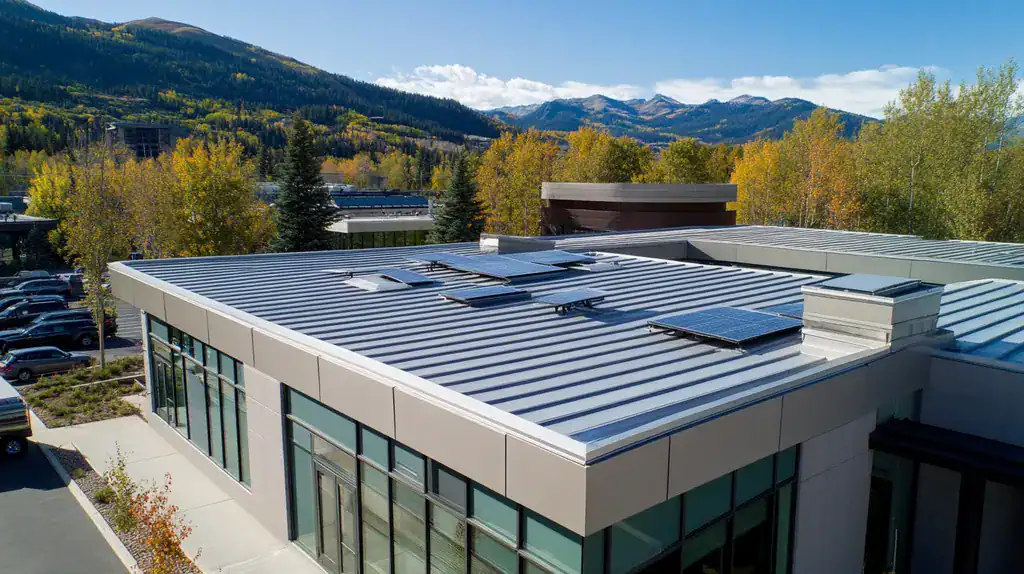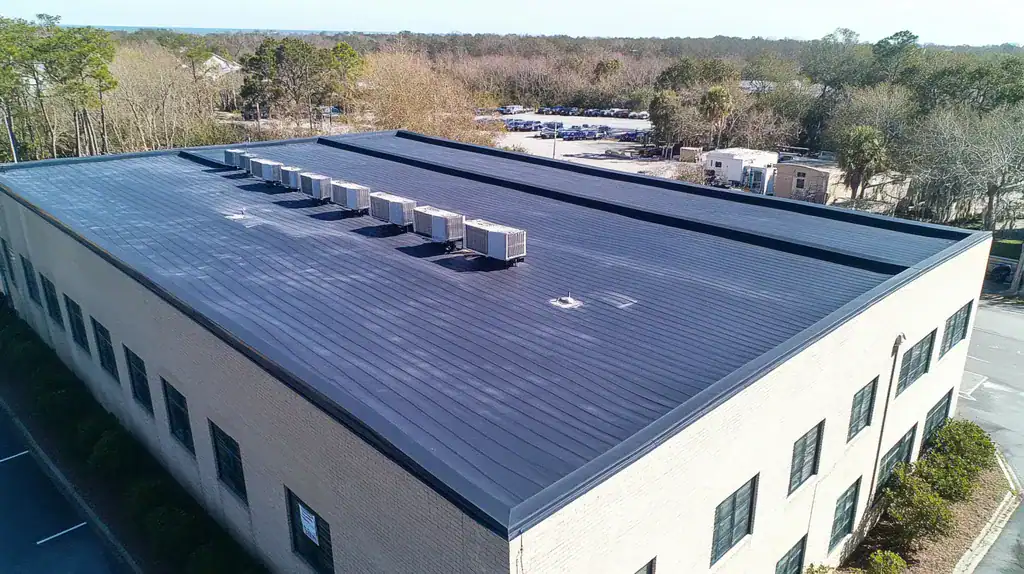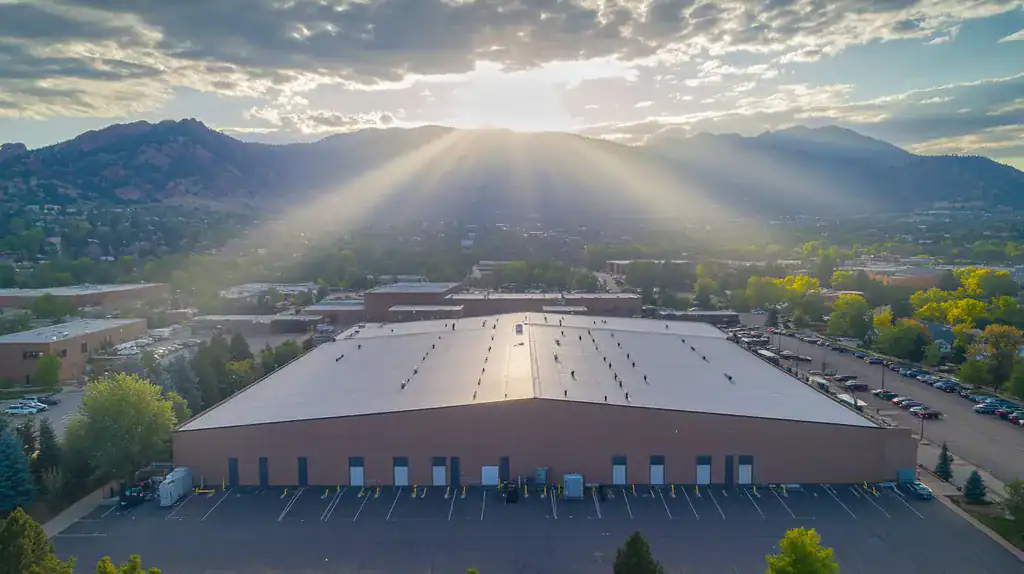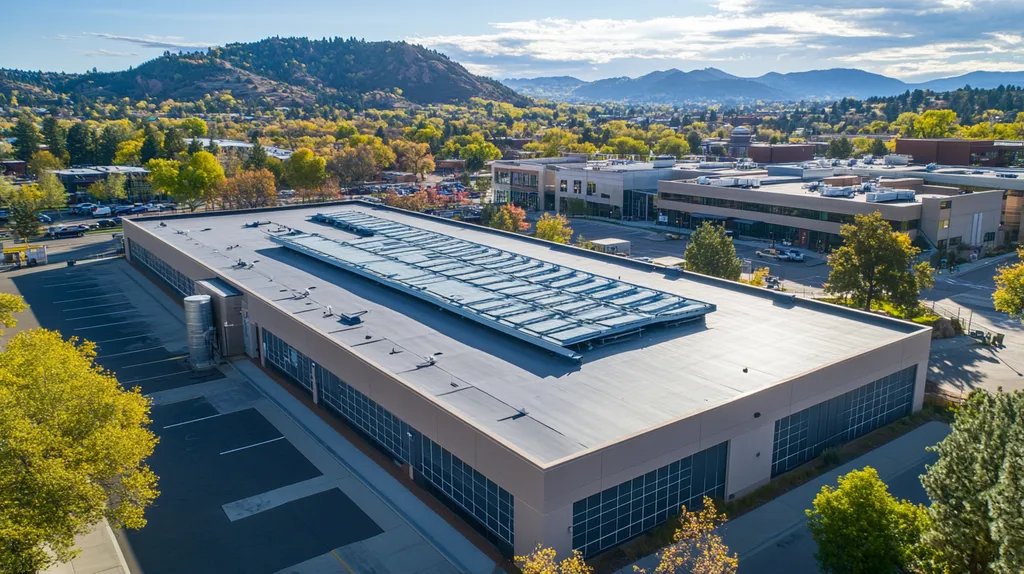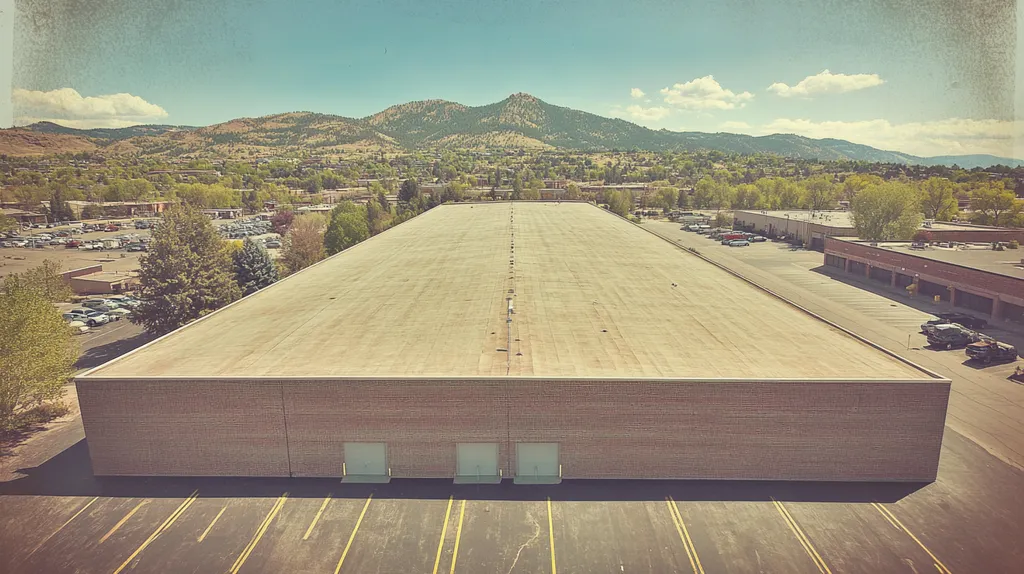Commercial roofs are failing at an alarming rate, with 85% of catastrophic failures traced to undetected issues that smart monitoring could have prevented. Traditional inspection methods miss up to 70% of developing problems until they become major structural threats.
Smart technology is revolutionizing how commercial buildings protect their most valuable asset. From IoT sensors and real-time monitoring to predictive analytics and automated responses, these innovations are transforming passive roofs into intelligent building systems.
This guide examines the key elements of smart roofing technology, exploring how modern monitoring systems reduce maintenance costs by 40% while extending roof lifespan by up to 25%.
SECTION 1: THE BASICS EXPLAINED
Commercial roofing faces unprecedented challenges from extreme weather events, rising energy costs, and increasing maintenance demands. Traditional inspection methods often miss developing problems until they become costly emergencies. Smart technology is revolutionizing how we monitor and maintain commercial roofs, offering real-time insights that prevent catastrophic failures and optimize performance.
What It Is (In Plain Language)
Smart roofing technology combines sensors, monitoring systems, and data analytics to create an intelligent roof management platform. These components work together to track crucial factors like moisture levels, temperature variations, and structural integrity.
Imagine your roof as a patient wearing a health monitor. Instead of waiting for symptoms to appear, sensors continuously check vital signs and alert you to potential issues before they escalate into major problems.
Modern smart roofing systems can detect even minor changes in conditions. When membrane separation begins or water starts pooling, the system immediately notifies facility managers through mobile alerts or dashboard warnings.
Why It Matters (To Your Building)
Smart technology transforms roofing from a passive barrier into an active building management tool. Integrating smart technology into commercial roofing systems is making monitoring and maintenance more efficient than ever, with IoT-enabled sensors tracking multiple conditions in real time. (source: CitiesABC)
Early detection through smart monitoring prevents minor issues from developing into major repairs. This proactive approach typically reduces emergency repair costs by 40% and extends roof lifespan by 25%.
Smart roofs also contribute to building efficiency. By monitoring temperature patterns and insulation performance, these systems help optimize HVAC operation and reduce energy consumption.
How It Works
Smart roofing systems operate through a network of strategically placed sensors that communicate with a central monitoring hub. These sensors measure key performance indicators including moisture presence, temperature fluctuations, and structural movement.
The collected data feeds into analytics software that identifies patterns and predicts potential issues. When conditions exceed normal parameters, the system generates automated alerts to facility managers.
Dashboard interfaces provide real-time visualization of roof conditions and historical performance data. This information enables managers to make data-driven decisions about maintenance timing and budget allocation.
Integration with building automation systems allows smart roofs to actively participate in overall building management. For example, roof sensors can trigger ventilation adjustments to prevent condensation or optimize solar reflection during peak cooling periods.
SECTION 2: PRACTICAL APPLICATIONS
Today’s commercial roofs face unprecedented challenges from extreme weather events, rising energy costs, and increasing sustainability demands. Modern smart roofing systems transform traditional roofs from passive barriers into active building management assets. Understanding how these technologies work in real-world applications is essential for property owners and facility managers seeking to protect their investments and optimize building performance.
Common Uses & Examples
Smart roofing systems excel at preventive maintenance through continuous monitoring. Embedded sensors track critical metrics like moisture penetration, temperature fluctuations, and structural movement, providing early warning of potential issues before they escalate into major problems.
Energy management represents another key application. Advanced systems monitor heat absorption and reflection patterns, automatically adjusting ventilation and insulation performance to optimize building efficiency.
Remote monitoring capabilities enable facility teams to inspect roof conditions without physical access. This reduces inspection costs while increasing inspection frequency and thoroughness.
Smart skylights and solar installations can be controlled remotely, allowing buildings to adapt quickly to changing weather conditions and energy needs. (source: ServiceTitan)
When You Need It Most
Smart roofing technology proves particularly valuable during extreme weather events. Systems can detect dangerous snow loads, ice dam formation, and ponding water, triggering immediate alerts before structural damage occurs.
During peak cooling and heating seasons, intelligent monitoring helps optimize energy efficiency. Real-time temperature and insulation performance data enable precise HVAC adjustments that reduce energy consumption.
Renovation and expansion projects benefit from smart roof integration. Historical performance data guides design decisions, while ongoing monitoring ensures new installations perform as specified.
Major maintenance planning becomes more strategic with smart technology. Predictive analytics help identify optimal timing for repairs and replacements, preventing emergency fixes and extending roof lifespan.
Interactions With Other Systems
Smart roofs function as integral components of comprehensive building management systems. Direct communication with HVAC controls enables automated adjustments to ventilation and climate control based on roof conditions.
Integration with drainage systems prevents water accumulation. Sensors detecting rainfall or melting snow can trigger preventive measures like heated drainage paths or increased pump activity.
Building security systems benefit from roof monitoring capabilities. Sensors can detect unauthorized access or equipment tampering, while structural monitoring warns of potential collapse risks.
Energy management platforms leverage roof data to optimize overall building efficiency. Solar production metrics, thermal performance data, and daylight sensors work together to reduce energy consumption while maintaining occupant comfort.
SECTION 3: KEY TERMINOLOGY DECODED
Clear understanding of roofing terminology directly impacts building performance and maintenance costs. Research shows that miscommunication between facility managers and roofing professionals leads to 45% of premature roof failures. Smart technology introduces additional technical concepts that must be properly understood to maximize investment value and prevent costly mistakes.
Essential Terms Explained
IoT sensors serve as the foundation of smart roofing systems, continuously collecting data about roof conditions. These sensors monitor critical factors including moisture levels, temperature variations, and structural movement patterns.
Membrane integrity refers to the continuous, unbroken state of the roofing material. Smart monitoring systems use advanced sensors to detect early signs of separation, punctures, or degradation before water infiltration occurs.
Building automation integration enables roof systems to communicate with other building components. This connectivity allows automatic adjustments to ventilation, drainage, and climate control based on real-time roof conditions.
The term “thermal mapping” describes the process of creating detailed temperature distribution profiles across the roof surface. These maps help identify insulation failures, moisture accumulation, and heat loss patterns.
Industry Jargon Translated
IoT-enabled sensors track temperature, humidity, and structural integrity in real time, transforming traditional roofs into intelligent building assets. These monitoring capabilities help reduce energy consumption while enhancing roof durability and performance. (source: CitiesABC)
“Load monitoring” refers to systems that measure weight distribution across the roof surface. This capability becomes crucial during snow accumulation or when equipment installations change roof stress patterns.
“Predictive analytics” describes software that analyzes sensor data to forecast potential problems. These systems identify developing issues weeks or months before they would become visible through traditional inspections.
“Smart drainage” encompasses automated systems that monitor and manage water removal. These systems adjust drain heating, pump activation, and flow patterns based on current conditions.
Measurement & Units Simplified
R-value measures insulation effectiveness, with higher numbers indicating better thermal resistance. Smart sensors track R-value performance in real-time, alerting managers when insulation efficiency decreases.
PSI (pounds per square inch) measures membrane compression strength. Monitoring systems track PSI variations to detect potential membrane failure points before leaks develop.
Slope ratio expresses roof pitch as a relationship between vertical rise and horizontal run. This measurement affects drainage patterns and influences sensor placement for optimal coverage.
BTU (British Thermal Unit) monitoring helps track heat transfer through the roof system. Smart technologies use BTU measurements to optimize energy efficiency and prevent condensation issues.
SECTION 4: DECISION FACTORS
Smart roofing technology represents a significant shift in how commercial buildings manage their most critical protective asset. Industry data shows that buildings without integrated roof monitoring systems face 40% higher emergency repair costs and 25% shorter roof lifespans. As technology costs decrease and extreme weather events increase, property owners must carefully weigh implementation factors that impact both immediate operations and long-term facility value.
Cost Considerations
Initial investment in smart roofing technology typically ranges from $2-5 per square foot above traditional systems. However, this cost difference is offset by reduced maintenance expenses and extended roof life.
Operating costs decrease significantly once smart systems are in place. Remote monitoring eliminates 75% of routine physical inspections while providing more accurate condition assessments.
Energy savings represent another major cost benefit. Intelligent monitoring and automated responses to changing conditions can reduce HVAC energy consumption by up to 20% through optimized roof performance.
Available incentives can substantially reduce implementation costs. Many utilities offer rebates for smart building technologies, while some municipalities provide tax benefits for energy-efficient roof upgrades.
Performance Trade-offs
Smart roofing systems require careful evaluation of sensor placement versus coverage needs. While more sensors provide better data, they also increase system complexity and maintenance requirements.
Data management capabilities must align with facility needs. Basic systems provide simple alerts, while advanced platforms offer predictive analytics and integration with building automation systems.
Network reliability impacts system effectiveness. Wireless sensors need consistent connectivity, while hardwired systems require additional infrastructure but offer more dependable operation.
Integration with existing building systems determines overall performance benefits. Smart roofs work best when they can directly communicate with HVAC, security, and energy management platforms.
Lifespan & Durability Factors
Smart roofing systems typically extend membrane life by 25-40% through early problem detection and prevention. Sensors track degradation patterns and environmental impacts, enabling targeted maintenance before damage occurs.
Component durability varies significantly between manufacturers. Critical elements like sensors and communication modules should carry warranties matching or exceeding the roof membrane’s expected lifespan.
Environmental conditions heavily influence system longevity. Exposure to extreme temperatures, high humidity, or corrosive atmospheres can impact sensor reliability and accuracy over time.
Integrating smart technology into commercial roofing systems transforms monitoring capabilities while enhancing building efficiency through real-time performance tracking. (source: CitiesABC)
SECTION 5: COMMON CHALLENGES
Despite advances in roofing technology, commercial buildings continue facing critical performance challenges that threaten both asset protection and operational efficiency. Industry data shows that 85% of roof failures stem from undetected issues that smart monitoring could have prevented. Understanding and addressing these challenges systematically can mean the difference between proactive maintenance and catastrophic failure.
Frequent Problems & Solutions
Water infiltration remains the leading cause of commercial roof failure, often occurring through membrane separations or compromised flashing. Smart moisture detection systems can identify these vulnerabilities before visible leaks appear, preventing extensive damage to building interiors.
The integration of Internet of Things (IoT) sensors provides continuous monitoring of roof conditions, enabling immediate detection of anomalies and supporting predictive maintenance approaches that minimize costly repairs and operational disruptions. (source: Blue Hammer Roofing)
Thermal stress from extreme temperature fluctuations can cause membrane deterioration and seam separation. Advanced thermal mapping helps identify stressed areas before failure occurs, allowing targeted intervention.
Poor drainage design or blocked systems lead to ponding water and accelerated deterioration. Smart drainage monitors can detect flow restrictions and alert maintenance teams before water accumulation becomes critical.
Warning Signs To Watch For
Surface blistering and membrane ridging indicate trapped moisture or air within the roofing system. Regular drone inspections with thermal imaging can detect these issues early, when repairs are still minimal.
Unusual energy consumption patterns often signal compromised insulation or membrane damage. Smart energy monitoring systems can isolate roof-related efficiency losses from other building systems.
Interior staining or dampness may indicate hidden leaks within the roof assembly. Moisture mapping technology can trace water migration patterns to their source, enabling precise repairs.
Membrane shrinkage and pulling at perimeters suggests material stress that could lead to system failure. Automated measurement systems track these dimensional changes over time.
Preventative Approaches
Implementing comprehensive monitoring systems provides real-time performance data across multiple roof conditions. This continuous oversight enables truly predictive maintenance rather than reactive repairs.
Regular calibration and verification of sensor networks ensures accurate data collection. Establishing baseline performance metrics helps identify subtle changes that might indicate developing problems.
Integration with building automation systems allows automated responses to changing conditions. Smart ventilation adjustments can prevent condensation while drainage controls respond to precipitation events.
Documenting all maintenance activities and system responses creates valuable performance history. This data drives better decision-making about repair timing and helps optimize maintenance scheduling.
SECTION 6: NEXT STEPS & RESOURCES
The transition to smart roofing technology represents a critical decision point for commercial property owners. Research shows that buildings without integrated monitoring systems face 40% higher maintenance costs and significantly shorter roof lifespans. As technology costs decrease and weather patterns become more extreme, understanding how to evaluate and implement these systems becomes essential for protecting both immediate operations and long-term facility value.
Questions To Ask Providers
Start by examining the provider’s integration capabilities. Ask specifically how their smart systems will connect with existing building automation platforms and what level of data sharing is possible between systems.
Request detailed information about the monitoring capabilities. Understanding alert thresholds, response times, and escalation procedures helps ensure the system meets your facility’s specific needs.
Investigate the provider’s track record with similar installations. Ask for case studies and references from buildings with comparable size, use, and climate conditions.
Clarify ongoing support services and maintenance requirements. Understanding sensor calibration schedules, software updates, and troubleshooting procedures prevents unexpected operational disruptions.
Industry Standards & Guidelines
Integrating smart technology into commercial roofing systems is transforming monitoring and maintenance capabilities through IoT-enabled sensors that track temperature, humidity, and structural integrity in real time. (source: CitiesABC)
The National Roofing Contractors Association (NRCA) provides comprehensive guidelines for smart roof implementation. Their technical bulletins outline best practices for sensor placement, monitoring protocols, and system maintenance.
ASTM International’s standards for electronic leak detection and moisture monitoring establish baseline performance requirements. These specifications help ensure system reliability and accuracy.
Local building codes increasingly address smart technology integration. Working with providers who understand regional requirements prevents compliance issues during installation and operation.
Further Learning Simplified
Professional organizations offer targeted education programs for facility managers. These courses cover system selection, implementation strategies, and performance optimization techniques.
Industry trade shows provide hands-on exposure to emerging technologies. These events offer opportunities to compare different systems and speak directly with manufacturers.
Technical workshops focus on practical aspects of smart roof management. Sessions typically cover data interpretation, preventive maintenance, and emergency response procedures.
Online resources from manufacturers and industry associations provide continuous learning opportunities. Regular review of these materials helps stay current with technological advances and best practices.
Looking Ahead
With 85% of catastrophic roof failures now preventable through smart monitoring, the industry stands at a technological turning point.
Smart roofing systems have proven their value by reducing maintenance costs up to 40% while extending roof lifespans by 25% or more.
The integration of IoT sensors, real-time monitoring, and predictive analytics transforms passive roofs into intelligent building assets that actively protect property investments.
As extreme weather events increase and energy costs rise, smart roof technology has moved from optional upgrade to essential infrastructure.
Commercial properties that delay implementation face significantly higher repair costs, shorter roof lifespans, and increased vulnerability to catastrophic failures.
The future of commercial roofing is intelligent, connected, and proactive – the only question is how quickly building owners will adapt.
FREQUENTLY ASKED QUESTIONS
Q. How does smart technology enhance commercial roof performance?
A. Smart technology uses sensors and data analytics to monitor roof conditions continuously. This proactive approach detects issues early, preventing costly emergencies and optimizing overall roof performance.
Q. What practical applications exist for industrial roof monitoring?
A. Smart roofs enable preventive maintenance, enhance energy management, and support remote condition monitoring. This technology offers effective solutions to protect investments and ensure optimal building performance.
Q. What key terminology should I know about commercial roofs?
A. Essential terms include IoT sensors, membrane integrity, and thermal mapping. Understanding these concepts is critical for successful communication with professionals and effective roof management.
Q. What decision factors influence smart roofing technology adoption?
A. Consider initial costs, performance benefits, and integration challenges. Evaluating these factors ensures that smart roof systems align with operational needs and long-term objectives.
Q. What common challenges arise with industrial roofs?
A. Frequent challenges include water infiltration, thermal stress, and drainage issues. Smart monitoring helps detect these problems early, allowing for timely interventions and preventive measures.
Q. What are the next steps for implementing smart roofing technology?
A. Begin by researching providers, asking key questions about integration and monitoring capabilities. Review industry standards and consider attending educational programs to ensure successful implementation.
Q. How does smart technology impact environmental sustainability in commercial roofs?
A. Smart technology optimizes energy consumption, reduces waste, and enhances material longevity. By monitoring conditions, it promotes sustainable practices and improves the overall environmental footprint of buildings.

